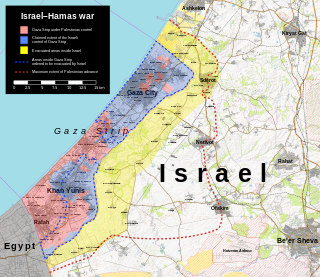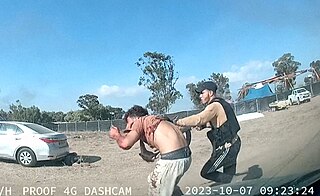
Linor Abargil is an Israeli lawyer, actress, model and beauty queen who won the Miss World 1998, shortly after being raped. Since then, she has become a global advocate in the fight against sexual violence. She was crowned by her predecessor Miss World 1997, Diana Hayden.
The Gaza–Israel conflict is a localized part of the Israeli–Palestinian conflict beginning in 1948, when 200,000 Palestinians fled or were expelled from their homes, settling in the Gaza Strip as refugees. Since then, Israel has fought 15 wars against the Gaza Strip. The number of Gazans killed in the most recent 2023 war — 27,000 — is higher than the death toll of all other wars of the Arab-Israeli conflict.

Sima Sami Bahous is a Jordanian diplomat and women’s rights advocate, and has served as Executive Director of UN Women since 2021. She previously served as Jordan's Ambassador to the United Nations from 2016 to 2021. Earlier, she was Assistant Secretary-General of the Arab League in Cairo, Egypt.

On 7 October 2023, Hamas and several other Palestinian militant groups launched coordinated armed incursions from the Gaza Strip into the Gaza envelope of southern Israel, the first invasion of Israeli territory since the Arab-Israeli War of 1948. Hamas and other Palestinian armed groups named the attacks Operation Al-Aqsa Flood, while in Israel they are referred to as Black Saturday or the Simchat Torah Massacre, and internationally as the 7 October attack. The attacks launched the ongoing Israel–Hamas war.

An armed conflict between Israel and Hamas-led Palestinian militant groups has been taking place chiefly in and around the Gaza Strip since 7 October 2023. It began when Hamas launched a surprise attack on southern Israel from the Gaza Strip. After clearing the militants from its territory, the Israeli military embarked on an extensive aerial bombardment of the Gaza Strip followed by a large-scale ground invasion beginning on 27 October. Clashes have also occurred in the Israeli-occupied West Bank and with Hezbollah along the Israel–Lebanon border. The fifth war of the Gaza–Israel conflict since 2008, it is part of the broader Israeli–Palestinian conflict, and the most significant military escalation in the region since the Yom Kippur War 50 years earlier.

On 7 October 2023, the Palestinian Islamist militant group Hamas initiated a surprise attack on Israel from the Gaza Strip. As part of the attack, 364 civilians were killed and many more wounded by Hamas at the Supernova Sukkot Gathering, an open-air music festival during the Jewish holiday of Shemini Atzeret near kibbutz Re'im. At least 40 hostages were also taken. This mass killing had the largest number of casualties out of a number of massacres targeting Israeli civilians in villages adjacent to the Gaza Strip, that occurred as part of the 7 October attack, alongside those at the moshavim of Netiv HaAsara, Be'eri, Kfar Aza, Nir Oz and Holit.

On 7 October 2023, in the opening attacks of the 2023 Hamas-led attack on Israel, Hamas militants carried out a massacre at Be'eri, an Israeli kibbutz near the Gaza Strip.

On 7 October 2023, as part of the Hamas-led attack on Israel at the beginning of the Israel–Hamas war, Hamas and other Palestinian militant groups abducted 253 people from Israel to the Gaza Strip, including children, women, and elderly people. In addition to hostages with only Israeli citizenship, almost half of the hostages are foreign nationals or have multiple citizenships. The precise ratio of soldiers and civilians among the captives is unknown. The captives are likely being held in different locations in the Gaza Strip.

On 27 October 2023, Israel launched an ongoing invasion of the Gaza Strip with the stated goals of destroying Hamas, a military and political movement that led an attack on Israel earlier in the month, and to free hostages taken by the group. Before the invasion, dubbed Operation Swords of Iron, Israel declared war, tightened its blockade, and ordered the evacuation of the northern Gaza Strip.

Since the start of the Israel–Hamas war on 7 October 2023, the UN Human Rights Council has identified "clear evidence" of war crimes by both Hamas and the Israel Defense Forces. A UN Commission to the Israel–Palestine conflict stated that there is "clear evidence that war crimes may have been committed in the latest explosion of violence in Israel and Gaza, and all those who have violated international law and targeted civilians must be held accountable." On 27 October, a spokesperson for the OHCHR called for an independent court to review potential war crimes committed by both sides.
Women in the Israel–Hamas war refers to the experience of Israeli and Palestinian women as victims of violence, combatants, leadership partners, and as participants in informational campaigns during the Israel–Hamas war. The conflict has been marked by violence towards women, including reports of rape and sexual violence by Hamas militants and reports of rape and sexual violence by IDF soldiers. Following the Hamas-led attack on Israel on October 7, 2023, there were testimonies and videos indicating that Hamas employed methods of severe torture, including violence and sexual violence against Israeli women and children. Over 100 Israeli women were taken hostage and held in Gaza, leading to efforts by Israeli women and organizations to raise awareness and promote their release. The UN Secretary-General and UN Women condemned the gender-based violence against Israeli women during the attacks.

Allegations have been made that the 2023 Hamas-led attack on Israel constituted a genocidal massacre against Israelis. In the course of the assault, Palestinian militants attacked communities, a music festival, and military bases in the region of southern Israel known as the Gaza envelope. The attack, which has been described as a "rampage of atrocities", resulted in the deaths of 1,163 people, two thirds of whom were civilians.
On 7 October 2023, 21-year-old French-Israeli woman Mia Schem was abducted by Hamas during the Re'im music festival massacre, part of the 2023 Hamas attack on Israel. Her abduction, a video of her in captivity in Gaza, and subsequent release on 30 November garnered international media attention, and she became a face of the hostage crisis during the Israel–Hamas war.
During the 2023-24 Israel-Hamas war, some Palestinian women and girls have reportedly been raped, assaulted by Israeli Defense Forces soldiers. The IDF has been accused of committing acts of gender-based violence, war crimes and crimes against humanity in keeping with the recognition of the International Criminal Court (ICC) that sexual violence is a war crime and a crime against humanity.
Anat Schwartz is an Israeli filmmaker, television director, data analyst, and freelance writer. Her films and the films she worked on, comprising mostly short documentary and narrative films, have been screened at major festivals, including the Cannes Film Festival. She gained significant media attention outside of her film work in 2024, in the context of broader controversies around the media coverage of the Israel–Hamas war, as one of the authors of "Screams Without Words"—a New York Times article about sexual and gender-based violence in the 7 October attack on Israel—which was heavily criticized for the quality of its reporting, which further led to a social media controversy and dissention within the paper.
In December 2023, a New York Times investigation titled "'Screams Without Words': How Hamas Weaponized Sexual Violence on Oct. 7" described rape and sexual violence during the 2023 Hamas-led attack on Israel, referring to such violence as having been "weaponized" by Hamas.

On 7 October 2023, 19-year-old Israeli woman Naama Levy was abducted by Palestinian militants during the 2023 Hamas attack on Israel. In one of the first videos released of the massacre, she was seen being dragged into a jeep at gunpoint, her hands bound and a large bloodstain on the seat of her pants, leading to widespread concern she had been raped or sexually assaulted.

During the Israel–Hamas war, the systematic torture of Palestinians by Israel was reported by the United Nations, Human Rights Watch, Amnesty International, and several Israeli nonprofit organizations. Israel was accused of sexual violence against both male and female Palestinian detainees, as well as torturing United Nations staff in order to extract forced confessions. There were further reports of the Israeli torture of accused militants. In response, Shin Bet officials stated they conduct militant interrogations within the Israeli legal framework, which allows torture only under specific circumstances.











